Overview
The performance of cooling fan modules is paramount for effective thermal management across diverse engineering applications, as it ensures that electronic components function within optimal temperature ranges. Recent advancements in cooling fan technology, including enhanced airflow designs and energy-efficient motors, significantly bolster their effectiveness and reliability. These improvements are crucial in meeting the escalating demands for efficient cooling solutions within the electronics sector, thereby solidifying the role of cooling fans as indispensable components in modern electronic systems.
Introduction
In the rapidly evolving landscape of electronics, thermal management has emerged as a critical factor in ensuring device reliability and performance. Gagner-Toomey Associates stands at the forefront of this industry, providing engineers with cutting-edge cooling solutions tailored to meet the demands of modern technology.
With a diverse range of products that include:
- Innovative cooling fans
- Thermal management systems
The company not only enhances operational efficiency but also addresses the growing need for sustainability in engineering practices. As the market for cooling solutions expands—driven by advancements in technology and an increasing focus on energy efficiency—Gagner-Toomey is uniquely positioned to empower engineers to tackle complex thermal challenges and contribute to the future of the electronics sector.
Gagner-Toomey Associates: Leading Provider of Cooling Solutions for Engineers
Gagner-Toomey Associates stands out as a premier supplier of temperature control solutions meticulously designed for engineers in the electronics sector. By presenting a diverse array of manufacturers, the company underscores cutting-edge technologies in temperature control, power management, timing, RF, and interconnect systems. This strategic approach not only enriches their portfolio but also guarantees that engineers access the latest advancements in temperature regulation solutions, including the cooling fan module and various other types of fans and their components.
Gagner-Toomey Associates prides itself on delivering exceptional customer support, a cornerstone of its corporate culture and unwavering commitment to fulfilling clients’ needs. With the Cooling System Market projected to attain a valuation of $157.26 billion by 2024, it plays a crucial role in meeting climate-conscious demands across multiple sectors.
Gagner-Toomey is strategically positioned to address the increasing demand for innovative thermal management solutions, with a strong focus on its cooling fan module and specialization in thermal, power, RF, interconnect, and electromechanical technologies. The company offers a focused selection of product lines, allowing for concentrated expertise in these domains.
Recent advancements, such as Advanced Cooling Technologies, Inc.’s breakthrough in Constant Conductance Heat Pipes for space applications and Siemens’ new thermal analysis tool for high-performance semiconductors, highlight the continuous innovation within this field. These developments reflect the company’s commitment to excellence and its customer-centric approach, empowering engineers to effectively navigate complex thermal management challenges and contribute to the evolution of the electronics industry.
As noted by Chitranshi Jaiswal, a Research Analyst Level I, ‘Her knowledge and skills have helped in making solid business decisions, securing funding from investors, and avoiding business failures,’ underscoring the significance of informed decision-making in the realm of cooling fan modules.
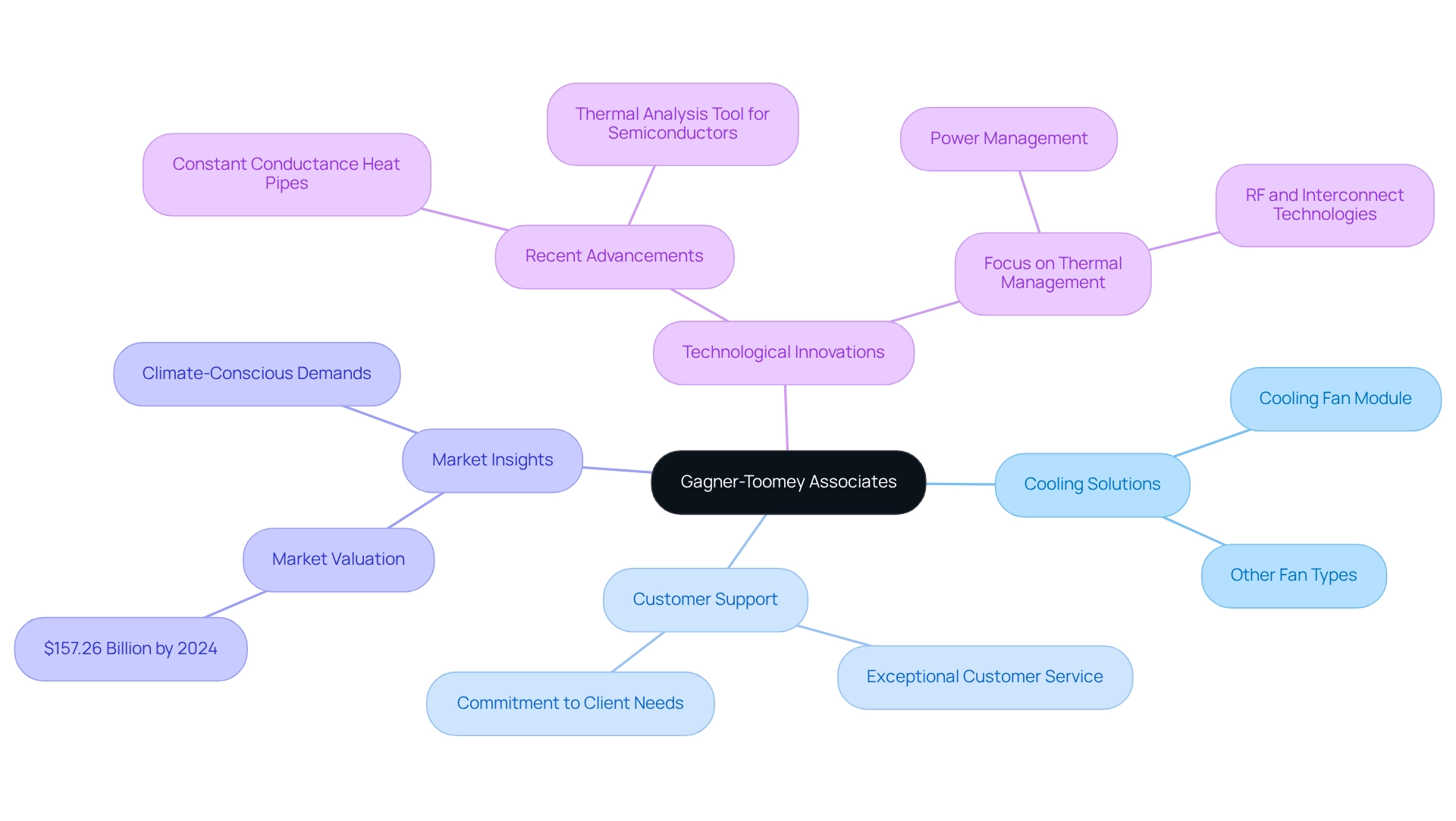
Cooling Fan Modules: Essential Components for Thermal Management
Cooling fan modules are essential for thermal management in various applications, such as automotive, industrial, and consumer electronics. These units are designed to effectively disperse heat generated by electronic components, thereby maintaining optimal operating temperatures. By regulating thermal conditions, the cooling fan module not only prevents overheating but also enhances overall performance and extends the lifespan of electronic devices, with recent advancements in cooling fan module technology significantly improving their efficacy.
For example, the introduction of innovative designs and materials has resulted in more efficient airflow and reduced noise levels, making them particularly suitable for sensitive electronic applications. Notably, Siemens unveiled a new 3D-IC thermal analysis tool in June 2024, which enhances thermal modeling for semiconductor applications, exemplifying ongoing innovation in the sector.
In automotive contexts, the cooling fan module is essential for managing the heat produced by high-performance engines and electronic systems, ensuring reliability and safety. Statistics underscore the importance of these components in thermal management; the thermal management technologies market was valued at USD 13.49 billion in 2023 and is projected to reach USD 27.50 billion by 2032, reflecting a compound annual growth rate (CAGR) of 8.24% from 2024 to 2032. Furthermore, North America represented a revenue share of 41% in the thermal management technologies market in 2023, highlighting the increasing reliance on efficient temperature regulation solutions within the electronics industry.
Expert insights further emphasize the significance of fan systems. Engineers assert that the cooling fan module and other components are vital for maintaining device functionality, particularly in high-density electronic environments where heat accumulation can lead to failures. Case studies illustrate their impact: for instance, recent breakthroughs, including advancements by Advanced Cooling Technologies, Inc. in Constant Conductance Heat Pipes for space-based applications, have facilitated improved thermal management in consumer electronics, enhancing device reliability and user satisfaction.
In conclusion, fan assemblies are not merely supplementary components; they are critical elements that ensure the effective operation of electronic systems, rendering them indispensable in today’s technology-driven landscape.
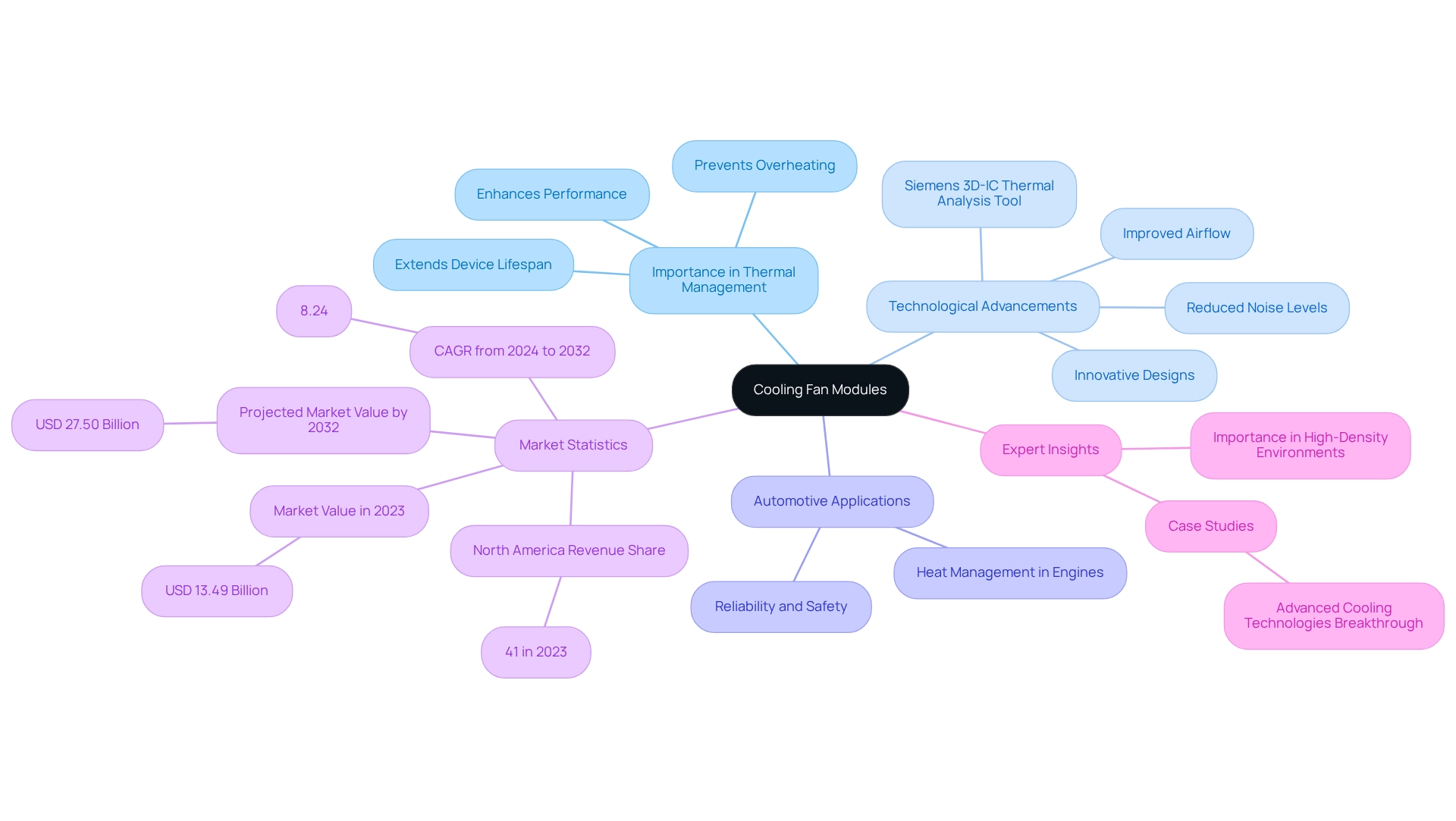
Key Technical Specifications of Cooling Fan Modules
When selecting fan units, engineers must prioritize several critical technical specifications to ensure optimal performance:
- Airflow Rate (CFM): This metric quantifies the volume of air the fan can move, making it essential for effective ventilation in electronic applications. The average airflow rate for fan modules in the electronics sector typically ranges from 30 to 150 CFM, depending on the application requirements. Gagner-Toomey Associates offers a broad product line of DC input tube axial units, with sizes ranging from 15 to 280mm, providing engineers with various options to meet their specific needs.
- Static Pressure: This specification measures the unit’s capability to overcome resistance within the system, which is particularly vital for setups with restricted airflow. A higher static pressure rating can significantly enhance cooling efficiency, especially in densely packed electronic environments. Gagner-Toomey’s centrifugal blowers, available in sizes from 15 to 225mm, are designed to deliver optimal static pressure performance.
- Noise Level (dBA): For applications where sound levels are critical, such as in consumer electronics, the noise output of the fan is a key consideration. Engineers frequently seek devices that operate below 30 dBA to maintain a quiet environment. Gagner-Toomey’s optimized designs ensure low noise levels without compromising performance.
- Power Consumption: This impacts both energy efficiency and operational costs. Choosing devices with reduced power usage can result in substantial savings over time, particularly in extensive implementations. Gagner-Toomey’s EC supporters and blowers, varying from 120 to 910mm, are designed for energy efficiency.
- Size and Form Factor: The device must fit within the design constraints of the application. Engineers should consider the physical dimensions and mounting options to ensure compatibility with existing systems. Gagner-Toomey offers standard and bespoke designs, featuring miniature blower solutions beginning at 15x3mm, addressing diverse spatial needs.
In a recent case study on designing and operating multiple fans, it was demonstrated that employing fans in parallel or series arrangements can enhance airflow and pressure performance, enabling engineers to fulfill specific temperature control needs efficiently. This strategic method underscores the significance of comprehending both airflow and static pressure when selecting cooling fan modules. For instance, the case study highlighted how particular airflow rates and static pressures were attained, providing practical insight into their effects.
As technology advances, staying informed about the latest trends in fan specifications is essential. Progress in materials and design is leading to more efficient fans with improved efficiency indicators. By concentrating on these key specifications, engineers can make informed choices that enhance the reliability and efficiency of their temperature control solutions.
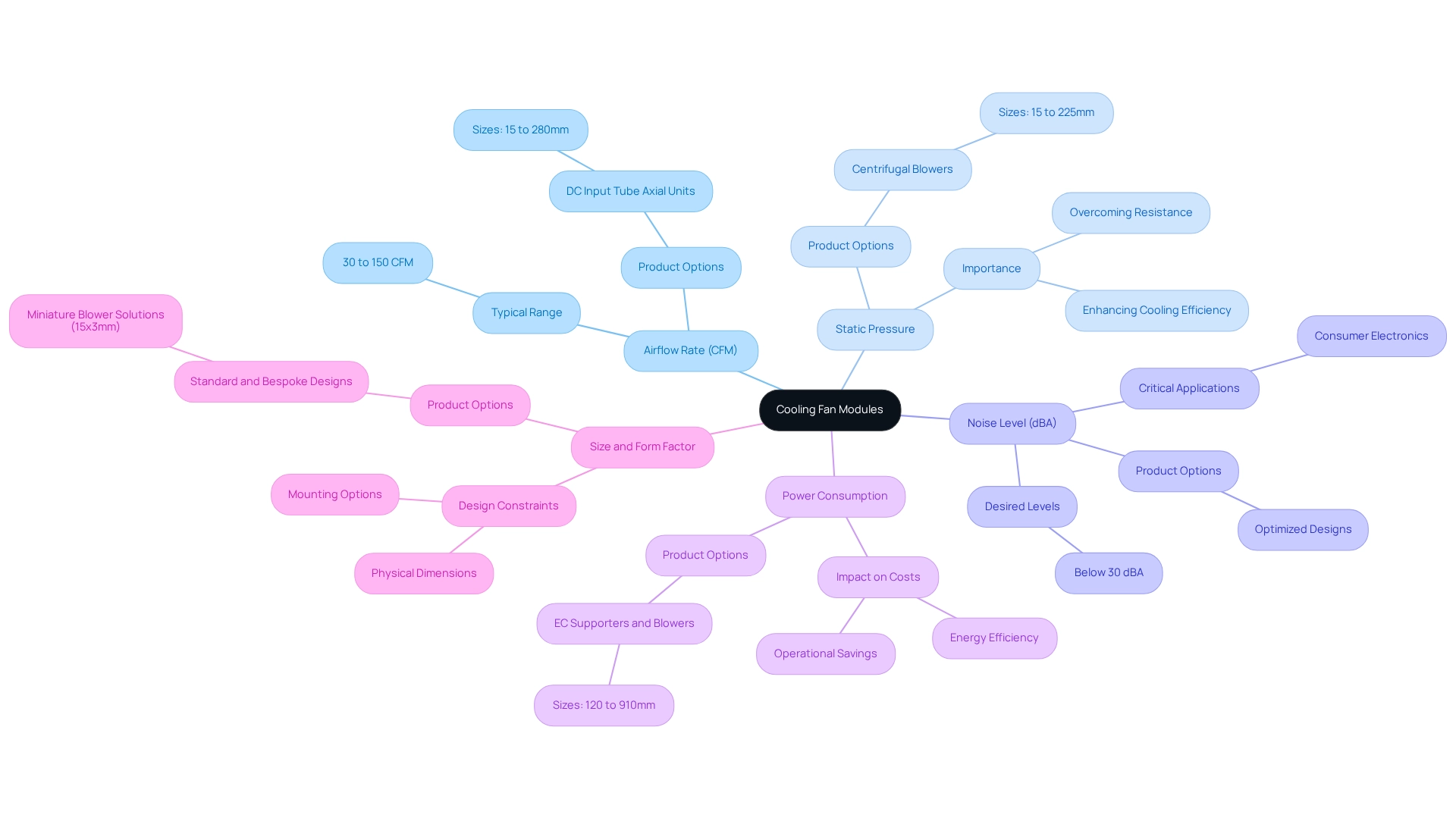
Common Challenges and Solutions for Cooling Fan Modules
Cooling fan modules face several significant challenges that can negatively impact their performance and reliability.
-
Overheating: This issue often arises when the fan is not appropriately sized for the application, resulting in inadequate cooling. To mitigate this, it is crucial to conduct thorough sizing and airflow calculations for the cooling fan module to ensure optimal performance.
-
Noise Issues: Excessive sound from ventilation systems can be disruptive, particularly in sensitive environments such as offices or laboratories. Selecting a cooling fan module specifically designed for low noise operation or implementing sound-dampening measures can effectively address this concern.
-
Vibration: Over time, vibrations can lead to mechanical failures in fan modules. Utilizing vibration-dampening mounts and ensuring proper installation of the cooling fan module can significantly reduce this risk, thereby enhancing the equipment’s longevity.
-
Power Consumption: High energy usage not only increases operational costs but also raises concerns about sustainability. Opting for energy-efficient designs that incorporate a cooling fan module and considering variable speed options can help minimize power consumption while maintaining performance.
The fan market is anticipated to expand considerably, with the existing market size estimated at USD 10,746.0 million in 2025 and a future projection of USD 29,967.0 million by 2035. This expansion is fueled by advancements aimed at addressing these obstacles, especially within the consumer electronics industry, where the demand for compact and energy-efficient temperature control solutions, like the cooling fan module, is high. For instance, the case study titled “Consumer Electronics Thermal Management Solutions” highlights how advancements in temperature regulation technologies are effectively tackling overheating challenges in devices such as smartphones and laptops. As producers concentrate on sustainability and efficiency, the advancement of innovative temperature control technologies continues to progress, ensuring that engineers have access to effective solutions for their refrigeration requirements.
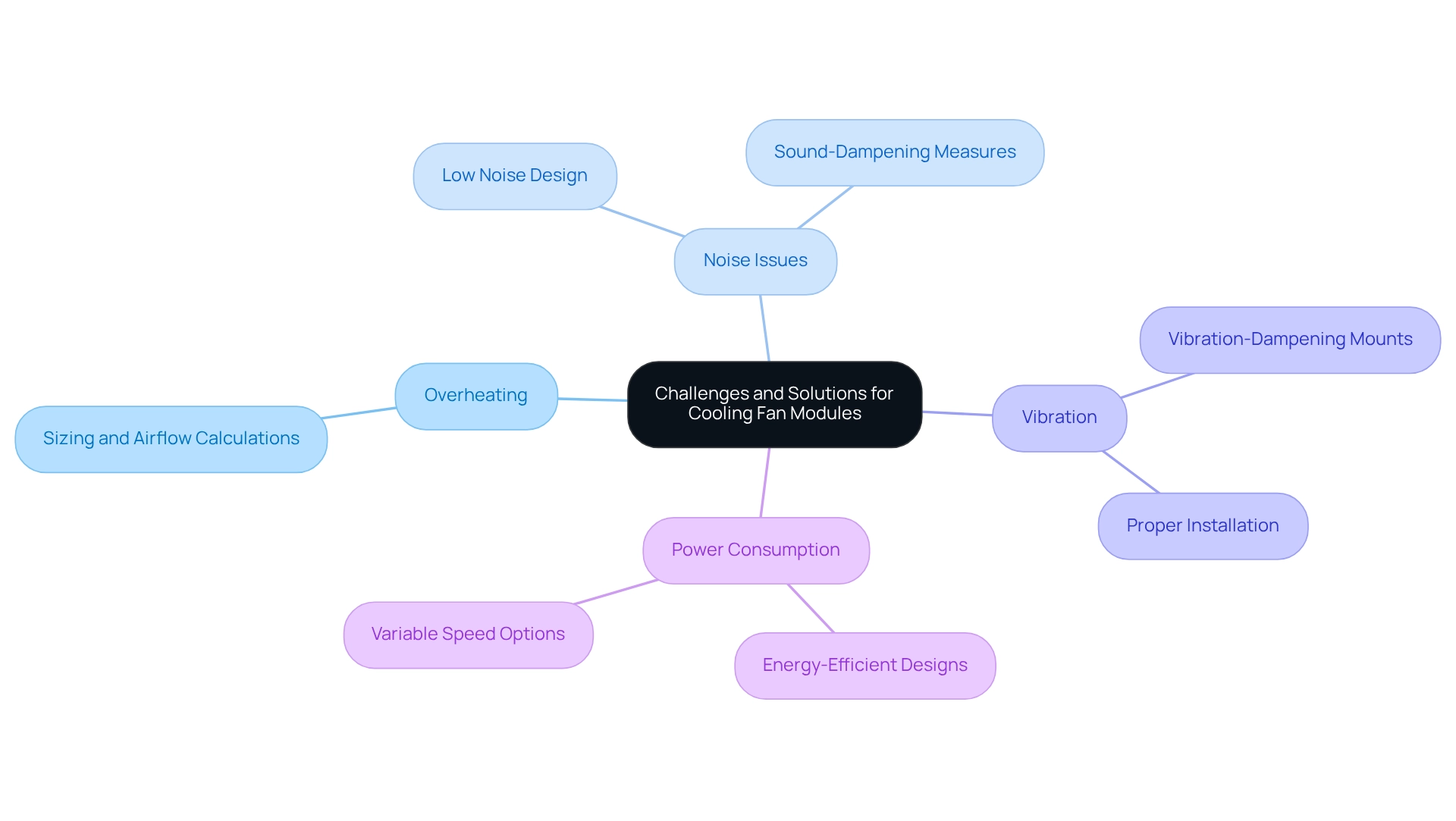
Types of Cooling Fan Modules: Choosing the Right One for Your Application
Cooling apparatus types are available, each designed for particular applications and requirements:
- Axial Units: Commonly utilized for general temperature regulation, these units provide high airflow at low pressure. They are especially efficient in situations where space is constrained and effective temperature regulation is necessary.
- Centrifugal Devices: Best suited for applications requiring higher static pressure, such as HVAC systems, centrifugal units excel in moving air against resistance, making them ideal for ducted systems.
- Brushless DC Units: Renowned for their energy efficiency and prolonged lifespan, brushless DC units are increasingly utilized in electronic devices. Their design minimizes wear and tear, leading to dependable operation over time, and the cooling fan module is specifically designed for settings with substantial airflow resistance, frequently employed in automotive temperature regulation systems, where it must navigate various barriers to sustain optimal temperatures.
Choosing the suitable cooling fan module depends on several essential factors, including airflow needs, spatial limitations, and noise levels. Comprehending these parameters is crucial for engineers to make informed choices that enhance system efficiency and reliability.
A recent analysis of fan sales channels, titled ‘Fan Sales Channel Segment Analysis,’ highlighted that direct sales allow manufacturers to maintain better control over branding and customer relationships. In contrast, specialty stores offer curated selections and expert advice, enhancing the overall customer experience.
As Saurabh Vidhate, Vice President of Sales, noted, ‘The rising demand for efficient thermal management solutions across various industries fuels the cooling fan module market during the forecast period.’ Additionally, with the collective market share of other firms varying between 15-20%, engineers must remain updated on the latest developments in refrigeration technologies to guarantee optimal application efficacy.
Gagner-Toomey Associates, a professional sales organization focused on the electronics industry, is well-positioned to assist engineers in navigating these choices.
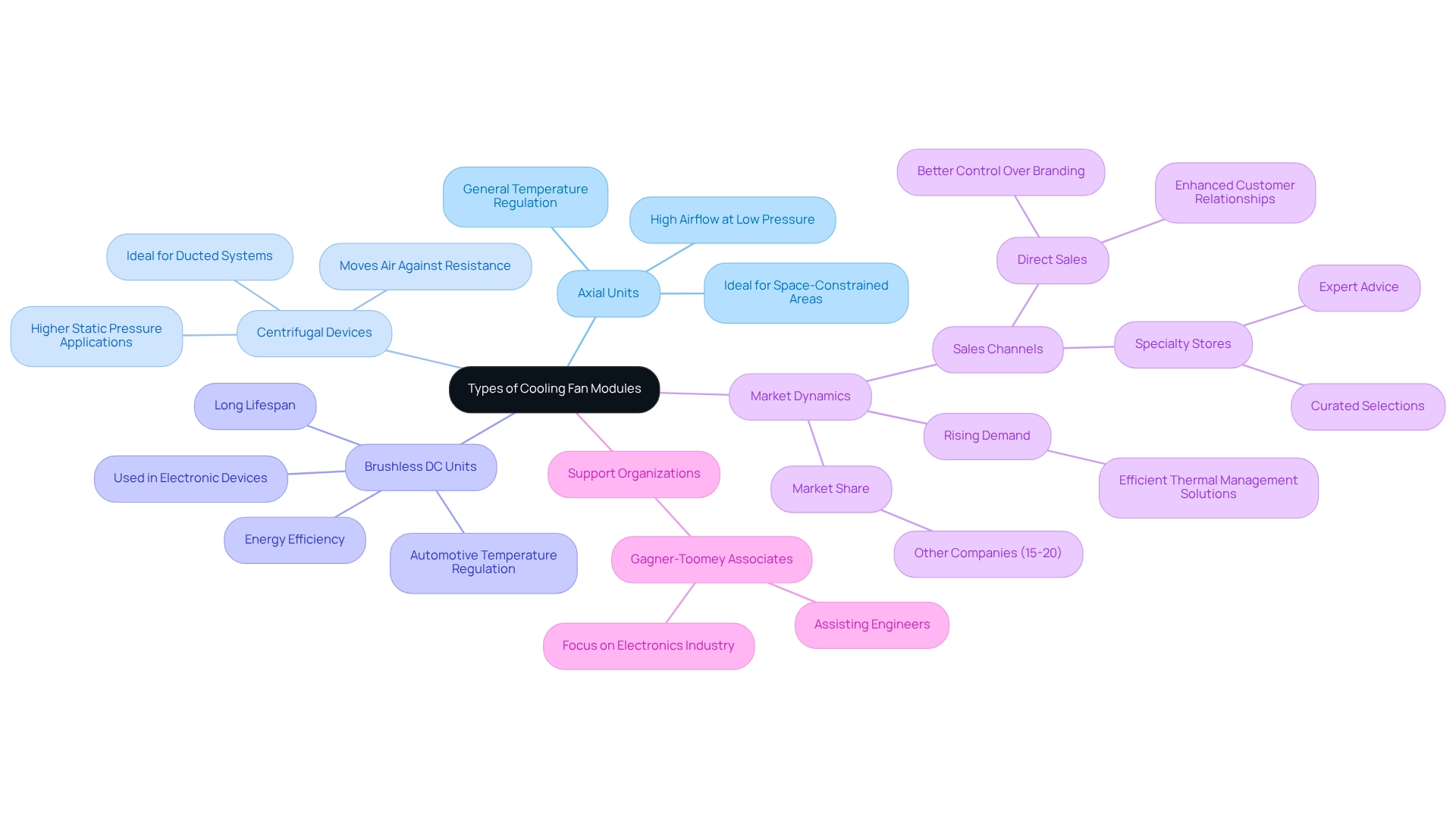
Installation Best Practices for Cooling Fan Modules
To ensure the optimal performance of the cooling fan module, it is essential to adhere to the following installation best practices:
-
Proper Orientation: Fans must be oriented correctly to facilitate airflow in the desired direction, which is crucial for effective cooling.
-
Secure Mounting: Employ appropriate mounting hardware to minimize vibration and noise, thus enhancing the operational efficiency of the fans.
-
Electrical Connections: It is vital to verify that all electrical connections are secure and insulated to prevent shorts, ensuring safety and reliability.
-
Testing: Conduct thorough testing post-installation to confirm that the cooling fan module operates as expected under load conditions, which is imperative for long-term performance.
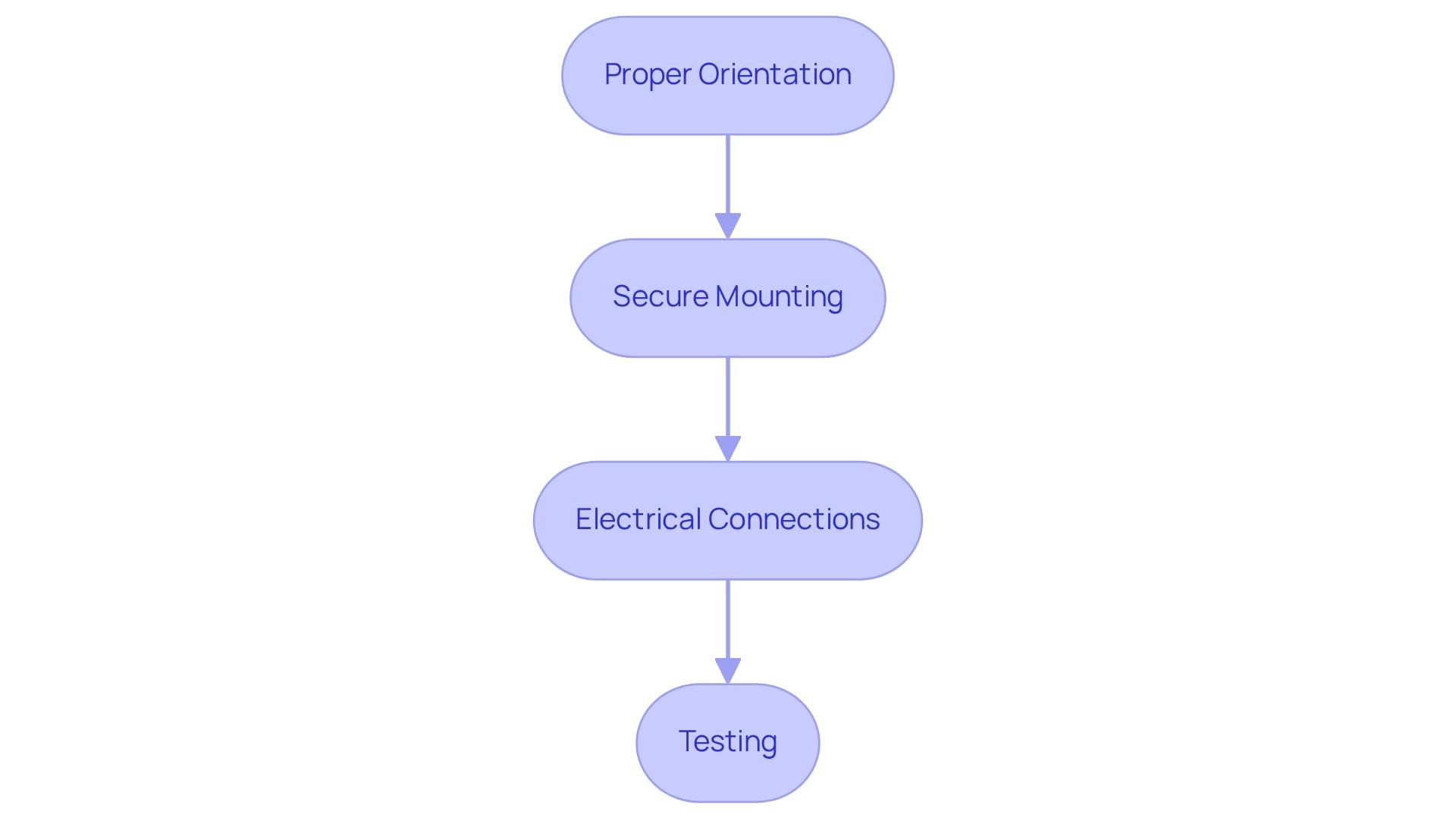
Energy Efficiency Considerations in Cooling Fan Module Design
Energy efficiency stands as a crucial element in the design of fan systems, particularly for Gagner-Toomey Associates, the world’s largest producer of both standard and custom air-movers. Key factors contributing to this efficiency include:
- Motor Efficiency: The selection of high-efficiency motors, as available in Gagner-Toomey’s extensive product line, significantly reduces power consumption.
- Variable Speed Control: The implementation of variable speed technology enables devices to adjust their speed according to temperature management needs, thereby optimizing energy use and enhancing the effectiveness of Gagner-Toomey’s solutions.
- Aerodynamic Design: The design of blade structures for optimal airflow, a hallmark of Gagner-Toomey’s engineering, enhances effectiveness while minimizing energy loss.
- Material Selection: Utilizing lightweight materials in the construction of blowers reduces the overall energy required for operation, further contributing to the efficiency of Gagner-Toomey’s advanced systems.
- Low Noise Operation: Numerous models are engineered for low noise operation, rendering them suitable for sensitive environments.
- IP Protection: Most models provide IP protection upon request, ensuring durability and reliability across various applications.
Gagner-Toomey’s product line encompasses DC input Tube Axial units ranging from 15 to 280mm and Centrifugal Blowers from 15 to 225mm, catering to a diverse array of industrial applications.
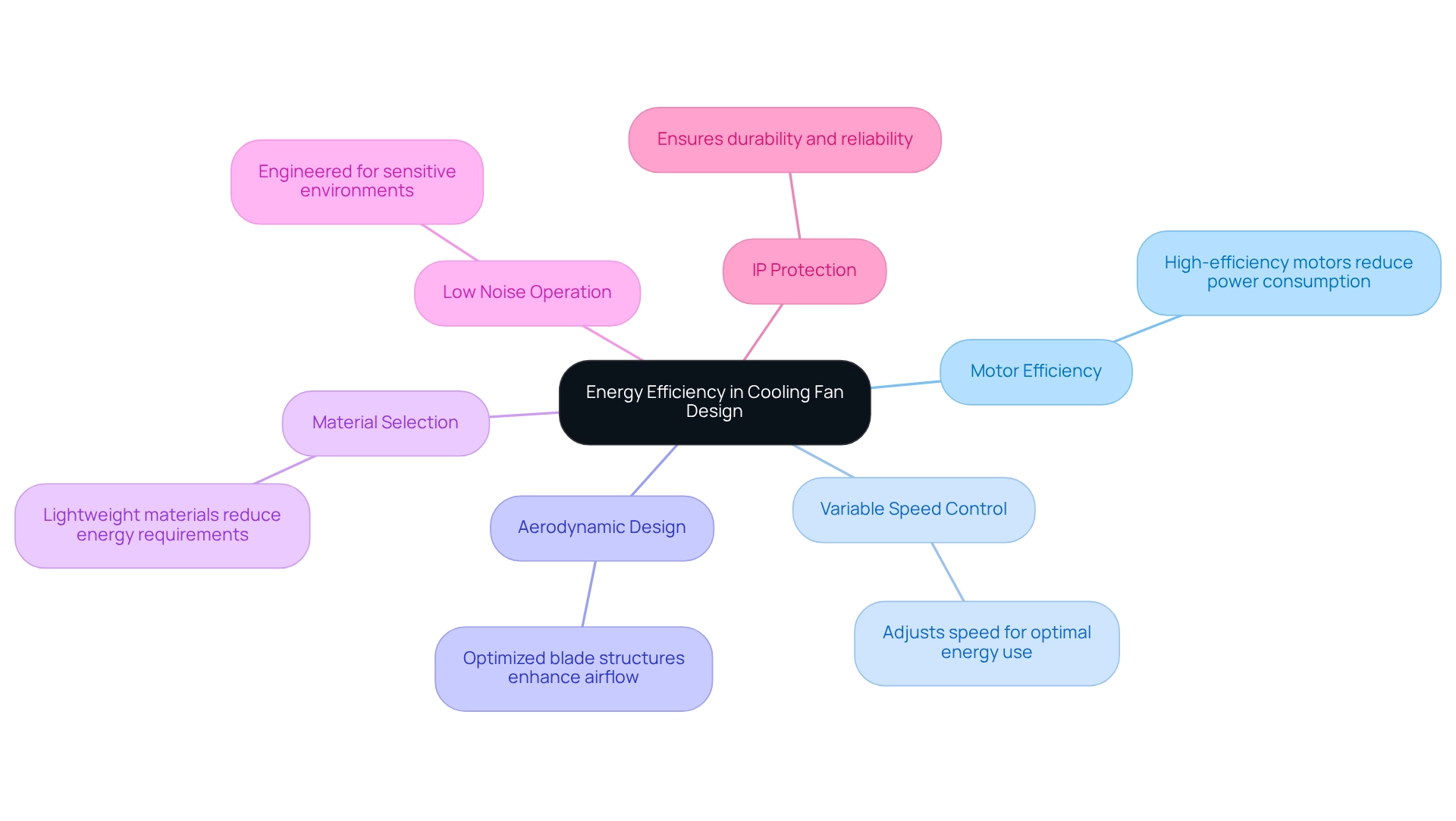
Top Brands for Reliable Cooling Fan Modules
When discussing dependable ventilation systems, several brands stand out for their unwavering commitment to excellence and efficiency.
- NMB Technologies is renowned for its high-quality, energy-efficient devices that cater to a variety of applications. Their cooling fan module systems are engineered to operate efficiently across a broad temperature spectrum, ensuring maximum performance in diverse environments.
- Delta Electronics, known for its innovative cooling fan module solutions, offers an extensive product range, including sophisticated 3-phase brushless DC units. Specifically designed for data centers and storage servers, these devices showcase enhanced efficiency and performance in critical applications. A compelling case study underscores that these devices represent the next evolution in technology, significantly improving operational efficiency within server environments. For instance, the Delta BFB0505MA-C model operates efficiently in temperatures ranging from -10°C to +70°C, making it a versatile option for demanding conditions.
- Sunon excels in providing advanced thermal management solutions, featuring high-performance fans that are vital for maintaining optimal operating conditions across various electronic devices.
- ebm-papst stands as a leader in energy-efficient fan technology, delivering tailored solutions for both industrial and commercial applications, ensuring reliability and sustainability in ventilation operations.
These brands not only dominate market share but also consistently achieve high customer satisfaction ratings, reflecting their dedication to quality and innovation in thermal technologies. Engaging with authorized distributors is encouraged to ensure reliability and support when sourcing these products. As of 2025, these brands maintain a significant presence in the market, underscoring their importance within the fan system landscape.
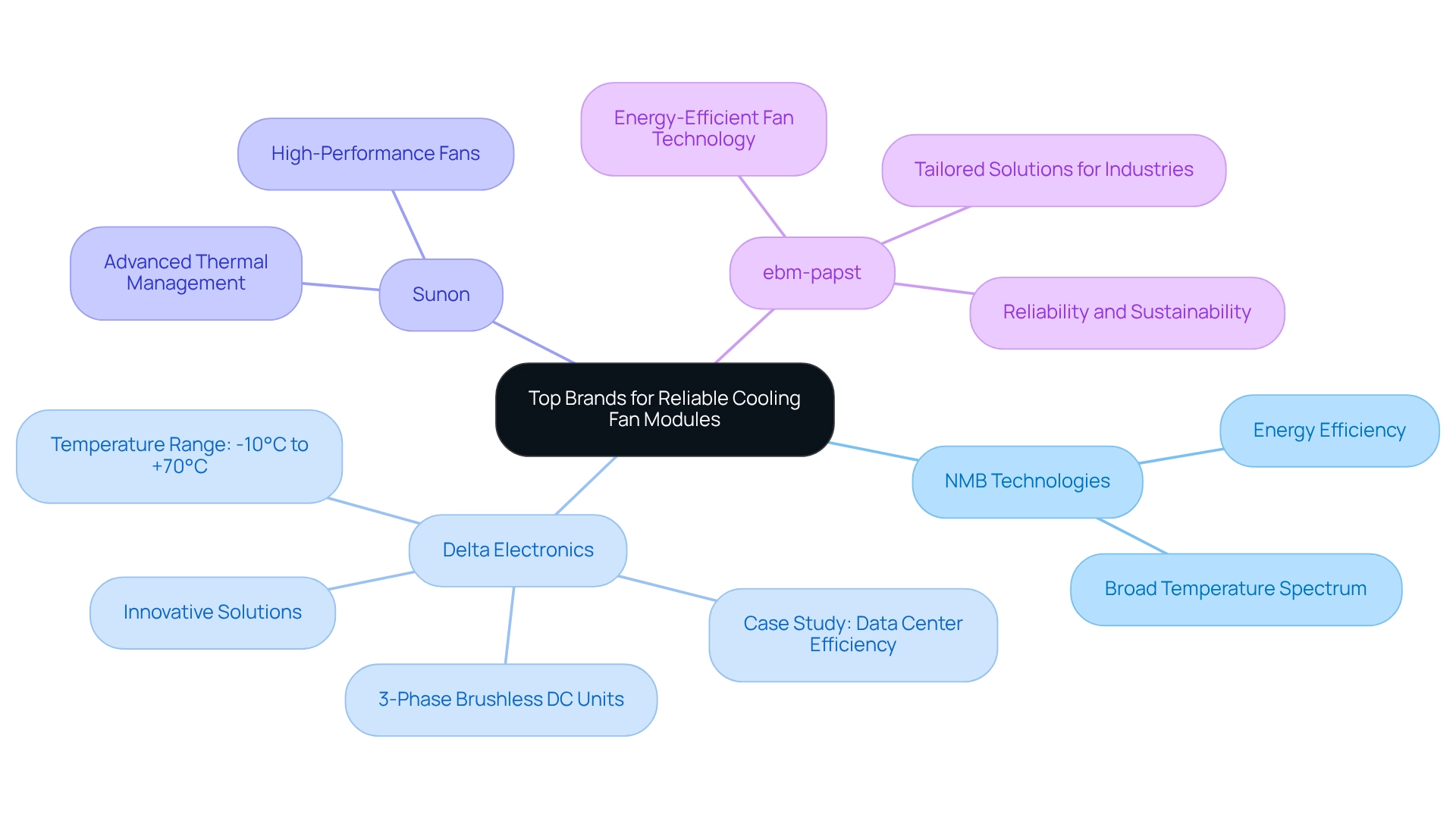
Innovations in Cooling Fan Module Technology
Recent innovations in temperature regulation fan module technology have significantly transformed the landscape of thermal management in electronics. Key advancements include:
- Smart Fans: Equipped with sensors and IoT capabilities, these fans dynamically adjust their operation based on real-time temperature data. This adaptability not only improves efficiency in temperature regulation but also aids in energy savings. Statistics indicate that the adoption of smart fan technology in electronics has increased by over 30% in the past year, reflecting its growing relevance.
- Brushless DC Motors: The adoption of brushless DC motors has revolutionized thermal management solutions by offering greater efficiency and extended lifetimes compared to conventional motors. Their dependability and effectiveness make them a favored option in contemporary cooling applications. As noted by P. Raftery, ‘The work also included a series of laboratory tests to discover the impact of various parameters: multiple fans in a space, ceiling height and fan diameter,’ emphasizing the significance of these motors in enhancing efficiency.
- Advanced Materials: The incorporation of lightweight and durable materials in fan design has enhanced functionality while simultaneously lowering energy usage. These materials improve the overall efficiency of refrigeration systems across various environments.
- Noise Reduction Technologies: With consumer electronics and HVAC systems demanding quieter operation, innovations aimed at minimizing noise levels have become increasingly important. These technologies enhance user experience without sacrificing thermal performance.
- Smart Ceiling Fans: Offering enhanced convenience, customization options, and integration with smart home platforms, smart ceiling fans are rising in popularity. Their ability to connect with other smart devices allows for improved energy management and user control.
Additionally, the “Global Comfort Data Visualization Tools” initiative illustrates the practical application of smart fan technology in analyzing comfort-related data on a global scale. These advancements not only enhance the functionality of refrigeration systems but also align with the growing trend towards smarter, more efficient electronics.
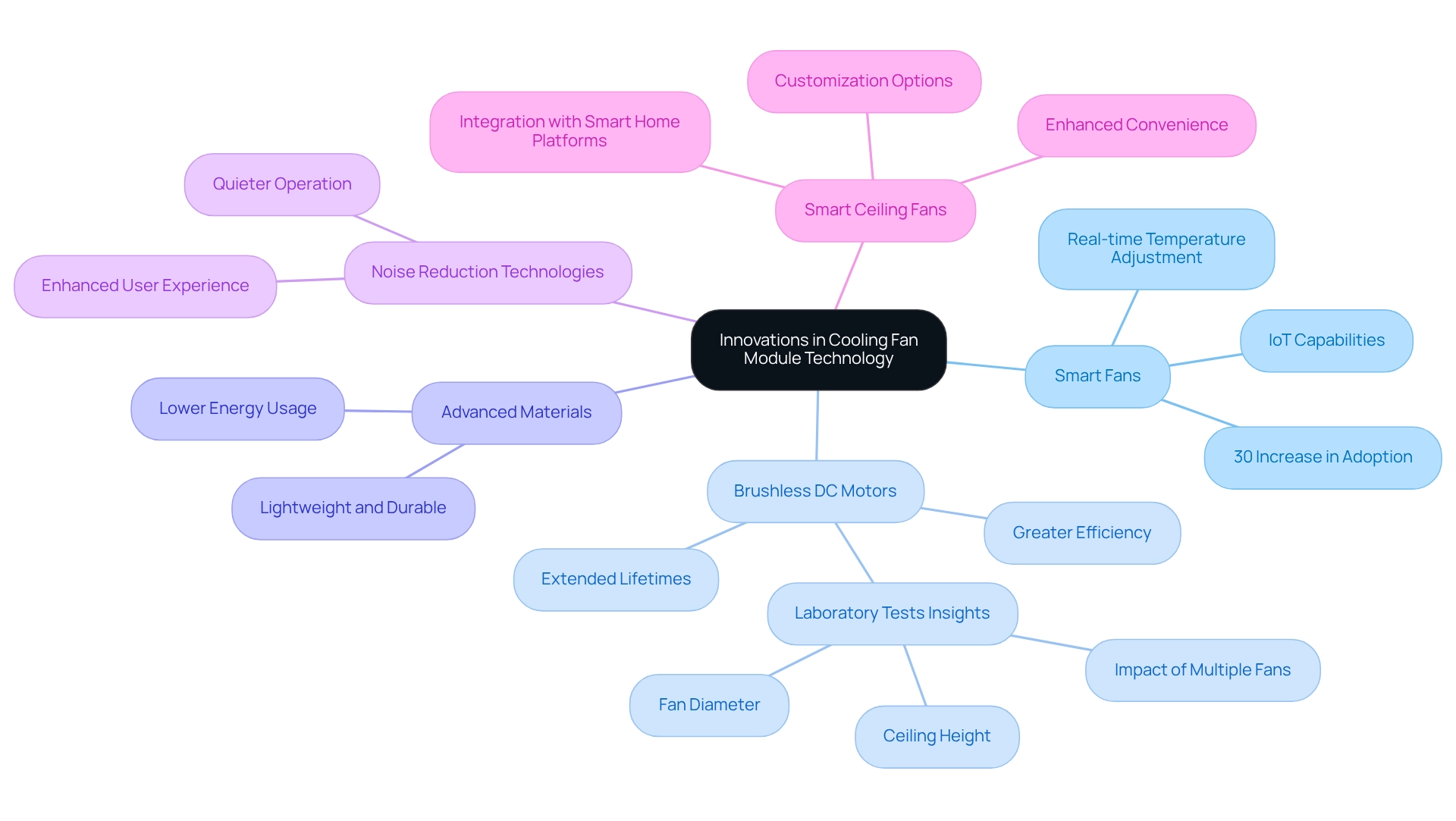
The Impact of Cooling Fan Modules on Engineering Applications
The integration of cooling fan modules is not merely beneficial but necessary for the advancement and reliability of technology across various sectors, where they play a pivotal role in engineering applications, addressing critical challenges and enhancing operational efficiency.
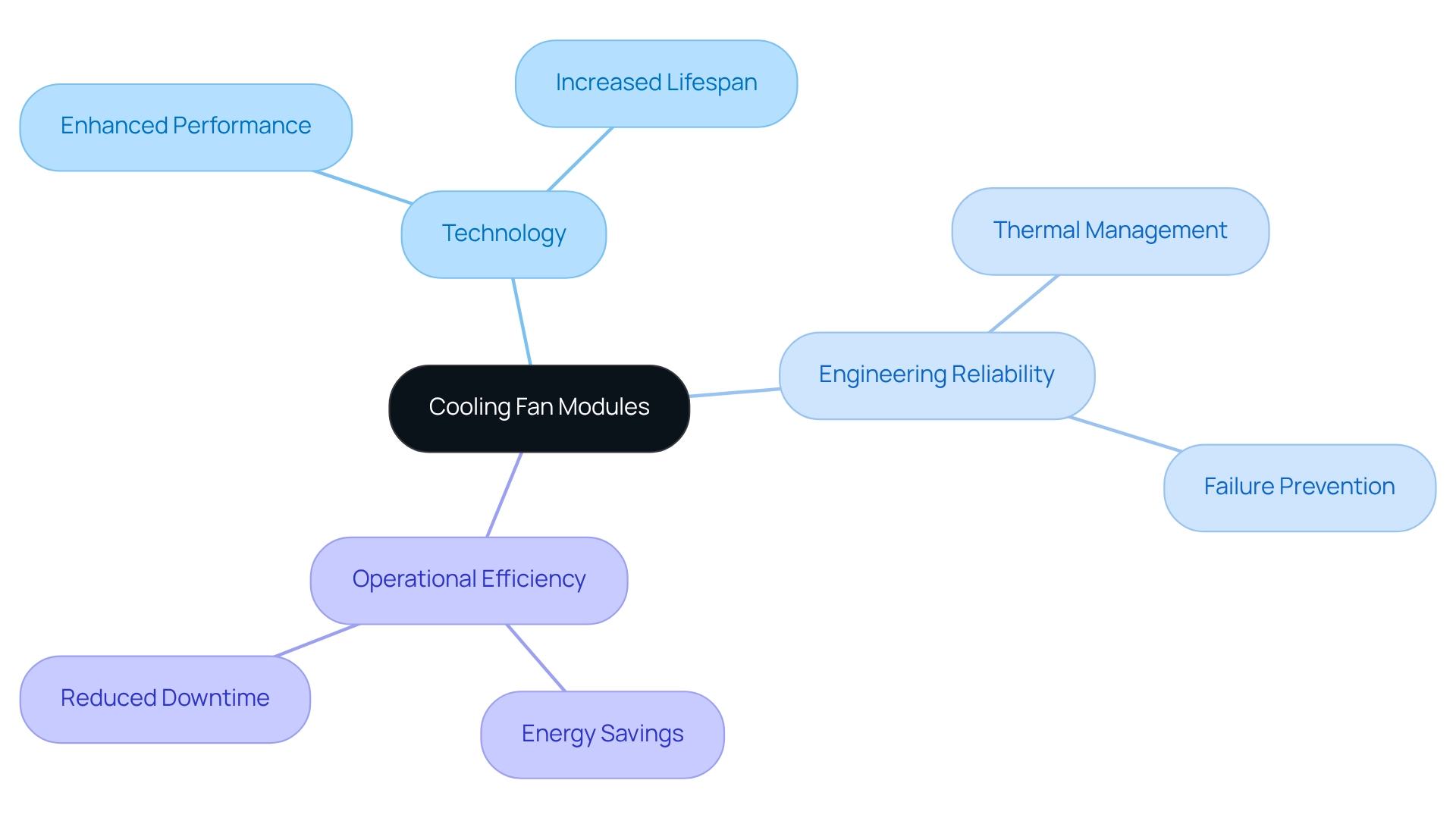
Conclusion
In the realm of electronics, effective thermal management is non-negotiable. Gagner-Toomey Associates emerges as a key player in providing innovative cooling solutions tailored for engineers. The company’s unwavering commitment to representing cutting-edge technologies across various cooling and thermal management systems empowers engineers to tackle complex challenges with confidence. As the market for these solutions expands, Gagner-Toomey stands poised to meet the increasing demands for both performance and sustainability.
Cooling fan modules are integral to maintaining optimal operating temperatures and play a pivotal role across diverse applications, from automotive to consumer electronics. The advancements in cooling fan technology—such as improved designs, materials, and energy efficiency—underscore the significance of these components in enhancing device reliability and performance. As engineers navigate the complexities of thermal management, understanding key technical specifications and best practices for installation becomes essential for maximizing the effectiveness of these cooling solutions.
Moreover, the landscape of cooling technology is continuously evolving, with innovations such as smart fans and brushless DC motors leading the charge. By prioritizing energy efficiency and noise reduction, Gagner-Toomey Associates not only addresses the current needs of the market but also sets the stage for future advancements in thermal management solutions. The ongoing growth of the cooling fan market reflects the critical role these technologies play across various sectors. With Gagner-Toomey’s expertise, engineers are well-equipped to drive progress in the electronics industry.
Frequently Asked Questions
What does Gagner-Toomey Associates specialize in?
Gagner-Toomey Associates specializes in temperature control solutions for engineers in the electronics sector, offering a diverse range of manufacturers and technologies related to temperature control, power management, timing, RF, and interconnect systems.
How does Gagner-Toomey Associates support engineers?
The company provides exceptional customer support and ensures engineers have access to the latest advancements in temperature regulation solutions, including cooling fan modules and various fan components.
What is the projected growth of the cooling system market?
The cooling system market is projected to reach a valuation of $157.26 billion by 2024, reflecting a growing demand for climate-conscious solutions across multiple sectors.
Why are cooling fan modules important in thermal management?
Cooling fan modules are essential for dispersing heat generated by electronic components, maintaining optimal operating temperatures, preventing overheating, enhancing performance, and extending the lifespan of electronic devices.
What advancements have been made in cooling fan module technology?
Recent advancements include innovative designs and materials that improve airflow efficiency and reduce noise levels, making them suitable for sensitive electronic applications.
What role do cooling fan modules play in automotive applications?
In automotive contexts, cooling fan modules manage heat produced by high-performance engines and electronic systems, ensuring reliability and safety.
What are the critical technical specifications engineers should consider when selecting fan units?
Engineers should prioritize airflow rate (CFM), static pressure, noise level (dBA), power consumption, and size/form factor to ensure optimal performance of fan units.
What is the significance of airflow rate and static pressure in cooling fan modules?
Airflow rate quantifies the volume of air moved by the fan, while static pressure measures the fan’s ability to overcome resistance in the system. Both are vital for effective cooling, especially in densely packed environments.
How can engineers enhance airflow and pressure performance in fan systems?
Engineers can enhance performance by employing fans in parallel or series arrangements, which allows for improved airflow and static pressure, meeting specific temperature control needs.
What trends are influencing the efficiency of cooling fan modules?
Advances in materials and design are leading to more efficient fans with improved performance indicators, making it essential for engineers to stay informed about the latest trends in fan specifications.
